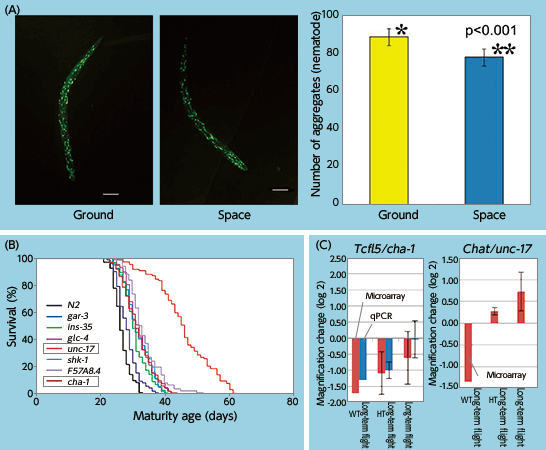TOP > Report & Column > The Forefront of Space Science > 2013 > Space and Aging
![]()

Life lengthens in space Fluorescent observation of nematodes , C.elegans, which expressed polyglutamine combined with green fluorescent protein (GFP), shows that the number of polyglutamine aggregates increase with age. Fewer polyglutamine aggregates were observed in C. elegans cultured in space than those on the ground. This suggests that the space environment affects life-span (Fig. 3A). 
In addition, the result of gene-expression analysis revealed that seven genes in the life-related gene cluster had reduced expression. When each of these genes was artificially inactivated on the ground, the lifespan of C. elegans was extended (Fig. 3B). This suggests that the life-related gene cluster becomes inactive in the space environment. Meanwhile, our study on the expression of the two mice genes corresponding to the seven genes of C. elegans showed that the expression of these genes was also reduced due to spaceflight (Fig. 3C). Further detailed analysis is required to answer the questions of whether the genes identified by C.elegans are related to cellular aging, whether the two mice genes are related to aging and/or life, etc. In the future, space experiments may help identify common life-related genes across genera. Conclusion The gene-analysis results of mice undergoing space flight strongly suggested that the space environment induces and accelerates cellular aging, while the results of C. elegans space experiments suggest that life is prolonged in space. How does the acceleration of cellular aging in space link to the phenomena of individual aging? On the other hand, although rapid-aging phenomena are triggered in space because of the significant degradation of biological function, is it possible that life is conversely extended due to decreased basal metabolism? It is expected that further space experiments and more detailed analysis will be carried out to elucidate aging phenomena. JAXA has initiated a study on development at its space-experiment facility using mammals such as mice and rats for the purpose of space biomedical research. There is still no clear evidence that the rapid changes in biological function of astronauts in the space environment are the same as the mechanism of slow aging phenomena on the ground at a cellular or molecular level. Nonetheless, as the life-related gene cluster in C. elegans was identified by space experiments, it is highly probable that we may obtain important knowledge on the molecular mechanism of biological-function changes associated with human aging through space experiments using mammals. Thus, it is expected that the space environment will become a useful experiment site for research into anti-aging medicine as well as basic science related to aging and life. (Noriaki ISHIOKA) References:
|
||||||||||||




